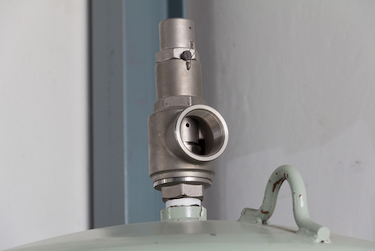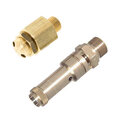Pressure Relief Valve For Air Compressors

Figure 1: A pressure relief valve at the discharge of a compressor
Pressure relief valves control and limit the pressure build-up in an air compressor system. If pressure exceeds what the pressure relief valve allows, the valve will automatically open and release air until the pressure reduces. Uncontrolled pressure from an air tank or compressor can damage downstream components if the pressure gets too high. Pressure relief valves prevent this by maintaining a constant set pressure in the system.
Table of contents
- What is a pressure relief valve for an air compressor
- Air compressor relief valve failure
- Air compressor relief valve opening
- Selecting a pressure relief valve for the compressor
- FAQs
View our online selection of safety and relief valves!
What is a pressure relief valve for an air compressor
Under normal conditions, a pressure switch or transducer controls the air pressure in a compressor. When the pressure switch reaches its cut-out set pressure, the compressor stops compressing air (unload) until it reaches the cut-in set pressure and starts compressing air again (load). The compressor cannot compress air or cannot stop if the pressure switch fails. Most air compressors have a high-pressure safety switch that stops the compressor if the pressure exceeds the unload set point.
A pressure relief valve or safety valve serves as a safety backup for the pressure switch and the high-pressure safety switch in case either fails with the compressor running. The air compressor pressure relief valve is set above the high-pressure switch and generally set at or below the vessel’s maximum operating pressure. Pressure relief valves open proportionally to the pressure increase above the setpoint, and close gradually. Safety valves open and blow off immediately upon the system pressure reaching the setpoint. Read our article on pressure relief valves vs safety valves for more details on the differences in their operation and design.
Pressure relief valves for air compressors contain spring-loaded mechanisms. The pressure from the spring’s tension keeps the valve closed in normal conditions. As the pressure increases in the pressure vessels, for example, an air tank, it eventually exceeds the relief valve’s rated pressure to open the valve and vent the excess pressure into the atmosphere.
According to American Society of Mechanical Engineers (ASME) standards for pressure relief valves, the valve reaches total discharge capacity when the system pressure climbs to no more than 10% above the set pressure of the valve. Full shutoff is necessary if the system pressure falls below the set pressure value, usually at 90%.
Air compressor relief valve failure
Failing with the pressure relief valve open
If a pressure relief valve becomes stuck in its open state, air continuously vents into the atmosphere, preventing the system’s air from becoming fully pressurized. An open relief valve can cause production loss and danger to personnel due to the flow of high-pressure air with flying debris and a dangerous sound level. Shut off the air compressor and replace the pressure relief valve before restarting it.
Failing with the pressure relief valve closed
If the pressure relief valve gets stuck in its closed state, it will not be able to vent the excessive pressure to maintain optimal air pressure within the compressor’s pressure vessels. The pressure inside the compressor continues to build, which can cause the storage tank to rupture, damage the compressor, and even injure the people and damage the property nearby.
Air compressor relief valve opening
A pressure relief valve in an air compressor opens when excessive pressure builds up inside the compressor, or the valve fails.
Excessive compressor pressure
If the pressure relief valve opens when the compressor pressure exceeds the valve’s set point, it indicates it is functioning correctly. But it also shows that the compressor has surpassed its maximum working pressure; hence, it is necessary to diagnose and rectify the condition that caused the excessive pressure.
Pressure relief valve failing
If excessive compressor pressure has not caused the pressure relief valve to open, it is most likely stuck in its open state. This happens mainly because of internal mechanical damage over time, meaning the valve is operating at a lower pressure than it should because its spring provides less counterpressure.
It is necessary to inspect the air compressor system when the pressure relief valve opens. First, determine whether the valve is open due to excessive compressive pressure or valve failure. Replace the valve if it doesn’t function properly.
Note: Never operate the compressor after the pressure relief valve opens without diagnosing the cause, as it can damage the property and risk people’s lives.
Selecting a pressure relief valve for the compressor
A pressure relief valve may not come with a pressure vessel purchased separately from the air compressor. It is crucial to add a pressure relief valve to ensure safe operation. There are a few factors to consider when selecting a pressure relief valve for an air compressor.
- Choose a pressure relief valve with its set point at or below the vessel's maximum allowable working pressure (MAWP). MAWP information should be available on a tag welded to the pressure vessel.
- The flow capacity of the pressure relief valve must exceed the total compressed air supplied to the vessel.
- The pressure relief valve’s minimum relieving capacity must meet the requirements of the ASME Code.
- The pressure relief valve's inlet port size should match that of the pressure vessel.
Read our article on sizing pressure relief valves for more details on how to size a relief valve for an air compressor.
Example
Consider two compressors with capacities of 600 and 850 cfm (16.8 and 21 m3/min, respectively) with a pressure vessel that has a maximum working pressure of 300 psi ( 20.7 bar). The minimum settings for a pressure relief valve would be:
- Set point: 300 psi (20.7 bar) or less
- Flow capacity: 1350 cfm (37.8 m3/min), which is the total compressed air supplied to the vessel
FAQs
What is an air compressor safety valve?
Safety valves or pressure relief valves in an air compressor control and limit the pressure build-up in the system.
How do you test an air compressor safety valve?
Turn the air compressor on and set it to function at its operating pressure. Pull the ring on the relief or safety valve to depressurize the system. Restart the system and ensure it comes back to its operating pressure.
What to do if an air compressor safety valve or pressure relief valve keeps opening?
Replace the safety valve if it remains stuck in its open state.







